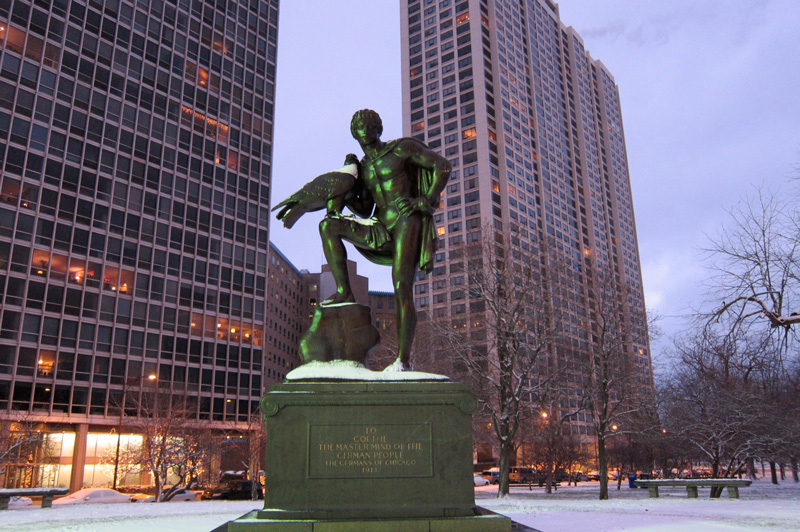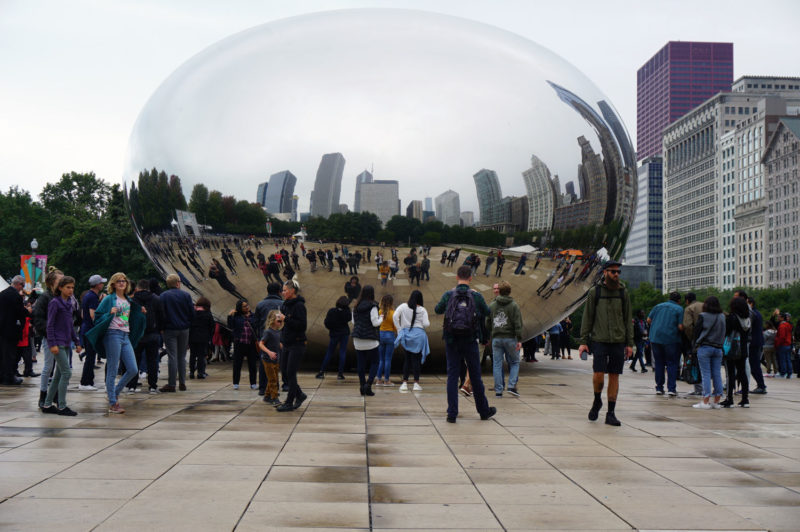The coming of spring has made me strangely nostalgic for the passing season. Nostalgic, yes; nostalgic for a season that wasn’t—for we didn’t really have a winter to speak of. The season was dry, with precious few days when one could go out and snap a picture like this.
Regardless of the possible merits of this picture, what can be said for the specifics of the scene? Is the place that it depicts, on the northern edge of Lincoln Park, in any respects a beautiful locale? Is it appealing? And what about the vaunted ethnic strains that are supposed to make living in Chicago so enriching and rewarding?
These are the questions that come to mind, as I gaze at this fairly absurd statue of Goethe, flanked on the left by a Mies van der Rohe building. Both speak to the once powerful German element in Chicago that’s vestigial now.
Both attest to different waves of city-building, waves that are constantly ebbing and flowing, creating the visual bric-a-brac that make up our surroundings. The wealthy Germans who had this statue erected in the public park in 1913 were asserting their cultural authority, memorializing a great writer from their native land, whose works remained a touchstone of their identity. Symbolically, this German statue “wars” with the more nationalistic statue of Alexander Hamilton located nearby. (A statue of the German-born Governor John Peter Altgeld, commissioned in 1913, is also hidden nearby in a grove.)
The commemoration of Germans, no matter how Americanized, came to a halt with the outbreak of World War I, as acceptance and admiration for Germans’ cultural heritage turned to suspicion and hostility.
Yet, with the advent of World War II, a German arrived who would once again change the face of the city: Mies van der Rohe, who swept away the beautiful old Chicago building traditions that Celia loves in favor of the modernist monoliths you see here. (And here.)
To make a long story short: In every community every building has a story. Let us praise waves of building that leave us with enduringly beautiful and admirable things. Even if you have never read a word of Goethe, you may still appreciate this statue from the bus, and let your imagination soar like the eagle you see.


Harley says
I’ve passed that statue many times while riding the bus to and from work. I never tire of looking at it.—-Good lighting on your photo.
Celia says
I like the lurid green of the statue, created when the streetlights came on at dusk. Normally its patina is brown.
Cornelia Lohs says
I love your blog! Thanks for commenting on one of my posts, that’s how I found your blog. I’ll be in Chicago again this summer on a research trip for my articles.
Celia says
Cornelia–Thanks! I love your b&w photography and am impressed that you have been someplace as obscure as Transylvania U. (I have always wanted to see that old Southern school.) Looking forward to getting to know you through your posts, Celia